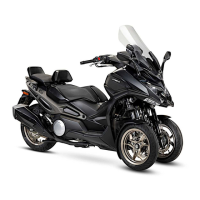
Do you have a question about the KYMCO CV3 Series and is the answer not in the manual?
| Displacement | 550.4 cc |
|---|---|
| Front Suspension | Telescopic fork |
| Rear Tire | 160/60-15 |
| Fuel Capacity | 15.5 liters (4.1 gallons) |
| ABS | Yes |
| Max Power | 51 hp @ 7500 rpm |
| Fuel System | Electronic fuel injection |
| Transmission | CVT |
| Front Brake | Dual disc |
| Rear Brake | Single disc |
| Weight | 280 kg |
| Seat Height | 795 mm |
| Max Torque | 53 Nm @ 5750 rpm |
| Front Tire | 120/70-15 |
Key safety guidelines for operating the vehicle, including rider gear and handling.
Safe practices for vehicle operation, loading, and parking, including fire prevention.
Advice on rider attire, avoiding modifications, and safe riding practices.
Precautions for parking safely and preventing fire hazards.
Guidelines on load capacity and restrictions for front attachments.
Fields to record Engine Number and Vehicle Frame Number for identification.
Details on where the engine number is engraved on the crank box.
Instructions on locating the frame number imprint on the motorcycle.
Guidance on finding the aluminum nameplate on the front frame.
Explains important vehicle markings like drive cautions, fuel tank labels, and logos.
Information on ECU data collection and how Kymco handles it.
Identifies components visible from the left side of the scooter.
Identifies components visible from the right side of the scooter.
Details the dashboard layout and control components on the handlebars.
Explains controls and indicators on the left handlebar's front section.
Explains controls and indicators on the right handlebar's front section.
Identifies and describes the function of central control switches.
Explains various indicators and displays on the LCD dashboard.
Guide to downloading and using the noodoe app and its functions.
Details on the keyless entry system, remote controllers, and battery replacement.
Explains the sensing ranges and operation of the keyless system sensors.
Instructions for using the main switch for locking, unlocking, and theft prevention.
How to lock and unlock the steering stem to prevent theft.
Describes the operation and behavior of the main switch.
Explains the functions of buttons on the right handlebar.
Details the operation of the anti-tilting lock for stability.
Explains the park alert switch, engine ignition, and engine stop switches.
Covers left handlebar switches including cruise control functions.
Explains how to use and indicates the status of the handlebar heater.
Instructions for operating the rear brake lever and its adjustment.
Instructions for operating the front brake lever and its adjustment.
How to use the parking brake arm to secure the vehicle.
Describes the function of the foot brake as an auxiliary braking system.
Explains the utility of the helmet hook.
How to open, close, and use the storage box, including load limits.
Steps for adjusting the windshield height for rider comfort.
Proper adjustment and importance of rear view mirrors for rider safety.
Guidelines and warnings for using the 12V power socket.
Information on adjusting the rider backrest for comfort.
How to switch the rear seat between solo and two-person modes.
How to use the main stand for parking and related safety precautions.
Instructions for opening, closing, and securing the fuel filler cap.
Explains TPMS operation, warnings, and abnormal status indicators.
Details the ABS system, its indicator, and operational cautions.
Explains the function of the O2 sensor in reducing exhaust pollutants.
Describes the role of the muffler and catalytic converter in exhaust systems.
Information about the exhaust control system and fire prevention.
Step-by-step guide to starting the vehicle's engine.
How to mount the vehicle and begin moving safely.
How to use the throttle grip to control scooter speed.
Explains the use of front, rear, and foot brakes.
Steps for parking the vehicle safely and maintaining stability.
Procedures for stopping the vehicle and preventing theft.
Steps to restart the vehicle after it has tipped over.
Importance of regular checks, maintenance, and safety precautions.
How to check and replenish engine oil and oil filter.
Guidelines for checking fuel levels and refueling safely.
Inspecting the steering stem and adjusting brake components.
Checking brake fluid levels and brake lining wear.
Inspecting brake lining effectiveness and tire condition.
Checking tire groove depth and understanding tire specifications.
Verifying the proper function of brake and tail lights.
How to check if the headlight is working correctly.
Checking the functionality and condition of the winkers.
Checking front/rear suspension, dashboard, horn, mirrors, and exhaust.
How to inspect the outer transmission belt for wear and damage.
Importance of regular and initial checks for vehicle maintenance.
Table detailing maintenance tasks and intervals for various vehicle systems.
How to check battery voltage and perform replacement.
Steps for replacing main and backup fuses, including specifications.
Instructions for removing, cleaning, and replacing the air filter element.
Cleaning and replacing the CVT transmission system filter wool.
Detailed steps for changing engine oil, including capacity and torque.
How to check, clean, and adjust the spark plug, including specifications.
Procedures for checking and replenishing coolant levels.
Explains the vehicle's emission control system and its components.
Details the E.E.C device for collecting evaporated oil and gas.
Technical specifications for the CV3 - SBA1CA model.
